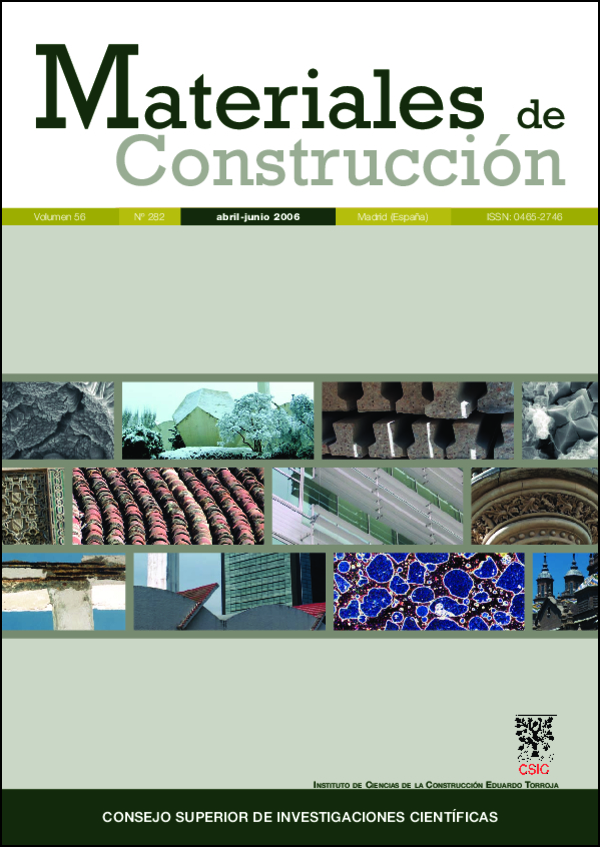Pore structure and carbonation in blended lime-cement pastes
DOI:
https://doi.org/10.3989/mc.2006.v56.i282.24Keywords:
kinetics, microstructure, carbonation, cement paste, limeAbstract
The present study aims to gain a fuller understandingof the curing process in lime pastes (100, 90, 80, 70,60, 50 and 40% lime) blended with cement by analyzingcarbonation in these materials. A hydrated, airslaked lime powder and CEM II A/L 32.5 Portlandcement were used for the blends. These materialswere singled out for research primarily because theymay be used in the restoration of heritage monuments.Variation in weight was used as an indicator for carbonation.A new parameter, A, was found to vary inverselywith the percentage of the cement because of theprevalence of Knudsen diffusion in the paste, in turndue to the characteristics of the pore structure, whichwas studied by mercury intrusion porosimetry (MIP).The hygroscopic study conducted on the different pastesprovided information on water content at a givenhumidity and its location, i.e., adsorbed on the surfaceof the pores or condensed inside them, obstructing thediffusion of CO2. The conclusion drawn from this studyof the curing process was that neither drying nor C3Shydration retarded lime carbonation.
Downloads
References
(1) Lanas, J., Perez Bernal, J. L., Bello, M. A., Alvarez, J. I.: “Mechanical properties of natural hydraulic lime-based mortars”, Cem. Concr. Res., 34 (2004), pp. 2191-2201. doi:10.1016/j.cemconres.2004.02.005
(2) Lanas, J., Alvarez, J. I.: “Masonry repair lime-based mortars: Factors affecting the mechanical behaviour”, Cem. Concr. Res., 33 (2003), pp. 1867-1876. doi:10.1016/S0008-8846(03)00210-2
(3) Degryse, P., Elsen, J., Waelkens, M.: “Study of ancient mortars from Salassos (Turkey) in view of their conservation”, Cem. Concr. Res., 32 (2002), pp. 1457-1563. doi:10.1016/S0008-8846(02)00807-4
(4) Houst, Y. F.; Wittmann, F. H.: “Influence of porosity and water content on the diffusivity of CO2 through hydrated cement paste”, Cem. Concr. Res., 24 (1994), pp. 1165-1176. doi:10.1016/0008-8846(94)90040-X
(5) Rodriguez-Navarro, C., Cazalla, O.: “Liesegang pattern development in carbonation traditional lime mortars”, Proc. R. Soc. Lond., 458 (2002), pp. 2261-2273.
(6) Steffens, A., Dinkler, D., Ahrens, H.: “Modelling carbonation for corrosion rick prediction of concrete structures”, Cem. Concr. Res., 32 (2002), pp. 935-941. doi:10.1016/S0008-8846(02)00728-7
(7) Lo, Y., Lee, H. M.: “Curing effects on carbonation of concrete using a phenolphthalein indicator and Fourier-transform infrared spectroscopy”, Build. Environ., 37 (2002), pp. 507-514. doi:10.1016/S0360-1323(01)00052-X
(8) Van Balen, K.; Van Gemert, D.: “Modelling lime mortar carbonation”, Mater. Struct., 27 (1994), pp. 393-398. doi:10.1007/BF02473442
(9) Cultrone, G., Sebastian, E., Ortega, M.: “Forced and natural carbonation of lime-based mortars with and without additives: Mineralogical and textural changes”, Cem. Concr. Res. (2005). (Disponible on line, sciencedirect.com.)
(10) Stazi, A., D’Orazio, M., Quagliarini, E.: “In-life prediction of hydrometric behaviour of building materials: an application of fractal geometry to the determination of adsorption and suction properties”, Build. Environ., 37 (2002), pp. 733-739. doi:10.1016/S0360-1323(01)00064-6
(11) Weimann, M. B., Li, V. C.: “Hydral behaviour of engineered cementitious composites (ECC)”, Restoration of Building and Monuments., 9 (5) (2003), pp. 513-534.
(12) Arandigoyen, M., Alvarez, J. I.: “Proceso de Carbonatacion en pastas de cal con distinta relacion Agua/Conglomerante”, Mater. Construcc. n. 281 (2005), pp 5-18.
(13) Arandigoyen, M., Perez Bernal, J. L., Bello Lopez, M. A., Alvarez, J. I.: “Lime pastes with different kneading water: pore structure and capillary porosity”, Appl. Surf. Sci., 252 (5) (2005), pp. 1449-1459. doi:10.1016/j.apsusc.2005.02.145
(14) Scherer, G. W.: “Structure and properties of gels”, Cem. Concr. Res., 29 (1999), pp. 1149-1157. doi:10.1016/S0008-8846(99)00003-4
(15) Lea, F. M.: The chemistry of cement and concrete, Glasgow, Edward Arnold (1970).
(16) Martin, A.: Ensayos y experiencias de alteracion en la conservacion de obras de piedra de interes historico artistico, Madrid, Ed. Fundacion Ramon Areces (1990).
(17) Arandigoyen, M., Alvarez, J. I.: “Blended pastes of cement and lime: Pore structure and capillary porosity”, Appl. Surf. Sci., In Press, Corrected Proof, disponible on line, 11 november 2005.
(18) Arandigoyen, M., Bicer-Simsir, B., Alvarez, J. I., Lange, D. A.: “Variation of microstructure with carbonation in lime and blended pastes”, Appl. Surf. Sci. (2005) (disponible en la web, Sciencedirect.com)
(19) Rilem, Mater. Struct., 13 (1980), pp. 175-253.
(20) Zelic, J., Rusic, D., Veza, D., Krstulovic, R.: “The role of silica fume in the kinetics and mechanisms during the early stage of cement hydration”, Cem. Concr. Res., 30 (2000), pp. 1655-1622. doi:10.1016/S0008-8846(00)00374-4
(21) Emanuelson, A., Hansen, S., Viggh, E.: “A comparative study of ordinary and mineralised Portland cement clinker from two different production units Part I: Composition and hydration of the clinkers”, Cem. Concr. Res., 33 (2003), pp. 1613-1621. doi:10.1016/S0008-8846(03)00115-7
(22) Torre, A. G. de la, Losilla, E. R., Cabeza, A., Aranda, M. A. G.: “High-resolution synchrotron powder diffraction analysis of ordinary Portland cements: Phase coexistence of alite”, Nucl. Instr. and Meth. in Phys. Res. B, 238 (2005), pp. 87-91.
(23) Stutzman, P.: “Scanning electron microscopy imaging of hydraulic cement microstructure”, Cem. Concr. Res., 26 (2004), pp. 957-966. doi:10.1016/j.cemconcomp.2004.02.043
(24) Basheer, L., Kropp, J., Cleland, D. J.: “Assessment of the durability of concrete from its permeation properties: a review”, Const. Build. Mat., 15 (2001), pp. 93-103. doi:10.1016/S0950-0618(00)00058-1
Downloads
Published
How to Cite
Issue
Section
License
Copyright (c) 2006 Consejo Superior de Investigaciones Científicas (CSIC)

This work is licensed under a Creative Commons Attribution 4.0 International License.
© CSIC. Manuscripts published in both the printed and online versions of this Journal are the property of Consejo Superior de Investigaciones Científicas, and quoting this source is a requirement for any partial or full reproduction.All contents of this electronic edition, except where otherwise noted, are distributed under a “Creative Commons Attribution 4.0 International” (CC BY 4.0) License. You may read here the basic information and the legal text of the license. The indication of the CC BY 4.0 License must be expressly stated in this way when necessary.
Self-archiving in repositories, personal webpages or similar, of any version other than the published by the Editor, is not allowed.


















